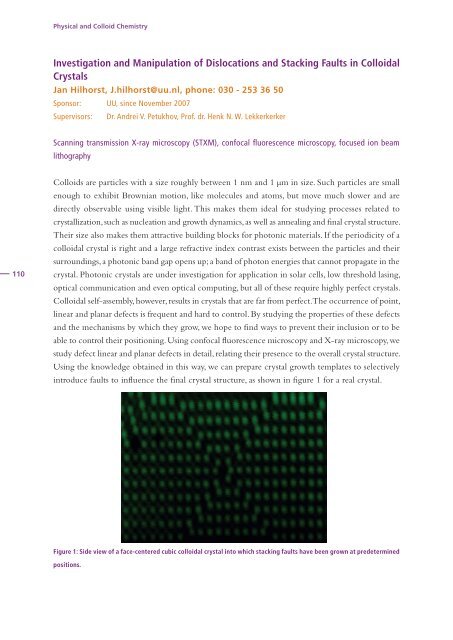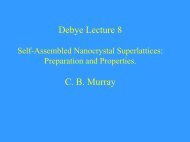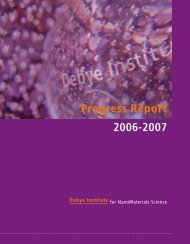Debye Institute for Nanomaterials Science
Debye Institute for Nanomaterials Science
Debye Institute for Nanomaterials Science
Create successful ePaper yourself
Turn your PDF publications into a flip-book with our unique Google optimized e-Paper software.
110<br />
Physical and Colloid Chemistry<br />
Investigation and Manipulation of Dislocations and Stacking Faults in Colloidal<br />
Crystals<br />
Jan Hilhorst, J.hilhorst@uu.nl, phone: 030 - 253 36 50<br />
Sponsor: UU, since November 2007<br />
Supervisors: Dr. Andrei V. Petukhov, Prof. dr. Henk N. W. Lekkerkerker<br />
Scanning transmission X-ray microscopy (STXM), confocal fluorescence microscopy, focused ion beam<br />
lithography<br />
Colloids are particles with a size roughly between 1 nm and 1 μm in size. Such particles are small<br />
enough to exhibit Brownian motion, like molecules and atoms, but move much slower and are<br />
directly observable using visible light. This makes them ideal <strong>for</strong> studying processes related to<br />
crystallization, such as nucleation and growth dynamics, as well as annealing and final crystal structure.<br />
Their size also makes them attractive building blocks <strong>for</strong> photonic materials. If the periodicity of a<br />
colloidal crystal is right and a large refractive index contrast exists between the particles and their<br />
surroundings, a photonic band gap opens up; a band of photon energies that cannot propagate in the<br />
crystal. Photonic crystals are under investigation <strong>for</strong> application in solar cells, low threshold lasing,<br />
optical communication and even optical computing, but all of these require highly perfect crystals.<br />
Colloidal self-assembly, however, results in crystals that are far from perfect. The occurrence of point,<br />
linear and planar defects is frequent and hard to control. By studying the properties of these defects<br />
and the mechanisms by which they grow, we hope to find ways to prevent their inclusion or to be<br />
able to control their positioning. Using confocal fluorescence microscopy and X-ray microscopy, we<br />
study defect linear and planar defects in detail, relating their presence to the overall crystal structure.<br />
Using the knowledge obtained in this way, we can prepare crystal growth templates to selectively<br />
introduce faults to influence the final crystal structure, as shown in figure 1 <strong>for</strong> a real crystal.<br />
Figure 1: Side view of a face-centered cubic colloidal crystal into which stacking faults have been grown at predetermined<br />
positions.






